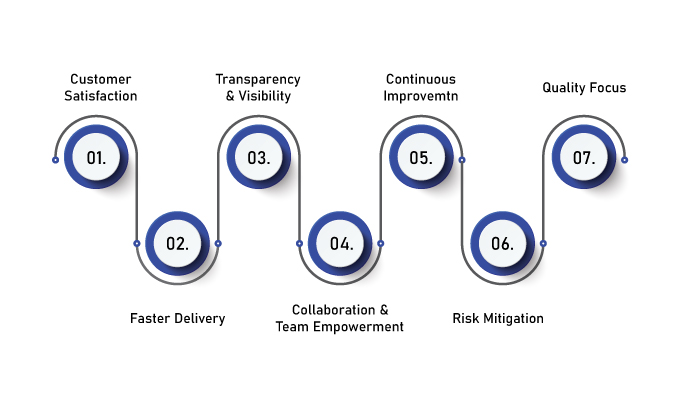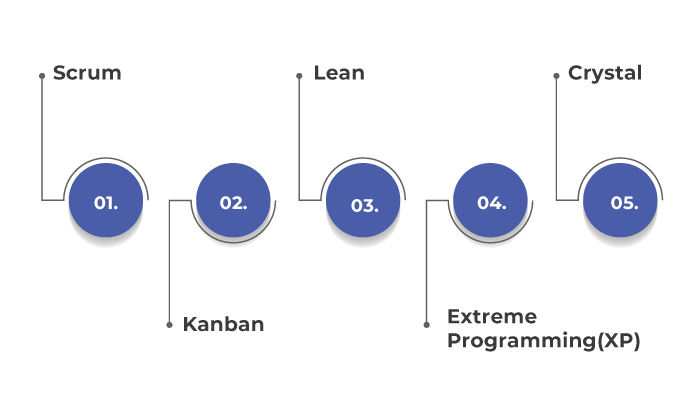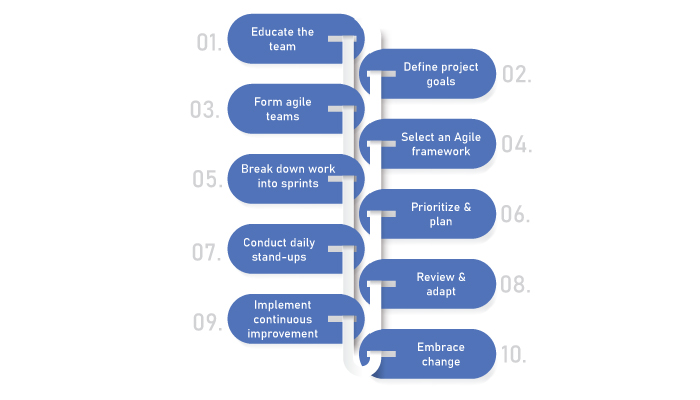Today to thrive in the competitive market agile methodology approach is the talk of the town. Traditional project management approaches often fall short of delivering desired outcomes.
That’s where agile comes in. Agile methodology provides a framework that promotes adaptability, collaboration, and continuous improvement to drive project success.
According to the report, 91% of organizations state that it is a strategic priority to adopt agile. Plus 81% of agile teams report using some version of Scrum, including Scrumban or a hybrid Scrum model.
The organizational areas and departments that have adopted agile are 86% in software development 63% in IT and 11% in sales.
Agile methodologies have several benefits let’s look at the blog and discover how agile empowers teams to deliver high-quality results and increase customer satisfaction.
Without further ado, let’s get started.
“The most efficient and effective method of conveying information to and within a development team is face-to-face conversation.” – Agile Manifesto
Agile History
The agile methodology definition says it is an iterative and flexible approach to project management and software development. It emphasizes collaboration, adaptability, and delivering customer value in small increments called iterations or sprints.
The agile manifesto was formulated by a group of software developers in Snowbird, Utah. It outlined a set of principles emphasizing flexibility, collaboration, and adaptability.
Moreover, agile methodologies promote cross-functional teams working closely together to continuously plan, develop, test, and deliver software or products.
The 2001 year the birth of Agile methodology after that many Agile frameworks have emerges such as Kanban, XP, and Scrum. Each of them has its principles and possesses high quality.
In the 1900s Scrum was introduced by Jeff Sutherland and Ken Schwaber and it became the most widely used Agile framework.
When it comes to agile vs waterfall methodology, Waterfall is the emergence of Agile it was the dominant software methodology. It follows a sequential approach with each phase of the project being completed while moving on to the next phase.
However, the history of Agile is marked by a shift away from traditional software development approaches. The adaptive mindset prioritizes customer value and continuous improvement.
What is agile methodology?
Agile methodology is an interactive and incremental approach to project management and software development. It was created as a response to traditional, linear project management methods.
When it comes to the Agile manifesto they prefer individuals and interactions over processes and tools.
It often faced challenges in adapting to changing requirements and delivering value promptly. Moreover, agile methodologies prioritize flexibility, collaboration, and customer satisfaction. They aim to deliver working software or products in short iterations, typically lasting a few weeks.
This approach allows for regular feedback and adjustments, ensuring that the final product meets the needs of the customer.
Open communication, trust among team members, and collaboration are the pillars of Agile. The team takes responsibility to deliver the project on time.
Although it doesn’t define by specific techniques it has a group of methodologies that provide tight feedback which led to continuous improvement.
Benefits of Agile Methodology Approaches
The methodologies of agile approach offer numerous benefits that contribute to project success and customer satisfaction. Here are some key benefits:
| Customer satisfaction | Emphasis on customer collaboration and feedback leads to a product that meets customer expectations.
|
| Adaptability to changes | Ability to embrace and respond to changing requirements, market conditions, and customer feedback.
|
| Faster time to market | It enables quicker delivery of working software or product increments.
|
| Risk mitigation | Early identification and mitigation of project risks reduce the likelihood of major setbacks.
|
| Higher quality deliverables | Continuous integration, testing, and feedback result in early issue identification and resolution.
|
| Continuous improvement | Another benefit is a culture of learning and improvement.
|
| Increased team productivity | Ownership, empowerment, and accountability within teams enhance productivity and motivation.
|
| Stakeholder engagement | The involvement of stakeholders throughout the project ensures alignment & ongoing engagement.
|
Why choose agile?

Most business chooses agile to respond to changes in the marketplace and get customer feedback in time. Choosing Agile has several benefits not only for project management but also for software development.
Although it is all about people, the Agile manifesto’s emphasis on the methods of conveying information to and within a development team is face-to-face conversation.
Moreover, delivering customer solutions is far most important than the detailed documentation
The main reason for choosing agile is that it allows flexibility and adaptability in a fast-paced business environment. Let’s look at more reasons why Agile is a popular and effective choice:
Customer satisfaction
We already know that agile methodology places a strong emphasis on customer collaboration and involvement. Regular feedback loops and iterative development ensure that the customer’s needs and expectations are continuously addressed. This led to an increase in customer satisfaction.
Faster delivery
Faster delivery is the main reason teams choose agile development methodology. It promotes incremental and iterative development which led to quicker delivery of working software or products.
When teams break down the project into smaller iterations, they release valuable features and functionalities more frequently.
Transparency and Visibility
Agile methodologies promote transparency within the team and with stakeholders. Regular process updates, demonstrations, and open communication foster a culture of trust.
This enables stakeholders to have a clear understanding of where the project is going and its status.
Collaboration and team empowerment
Another main reason teams choose this methodology is that it encourages a mindset of continuous improvement. Through retrospectives and regular reflection, the team identifies areas for enhancement and implements changes.
This led to the optimization of processes and significant increases in efficiency.
Continuous improvement
With the mindset of continuous improvement through retrospectives and regular reflection, teams identify areas for enhancement. It implements changes to optimize processes, increase efficiency and deliver better results with each iteration.
Risk Mitigation
The agile methodology incorporates risk management practices throughout the project lifecycle. BY delivering working increments early, risks are identified sooner.
The agile iterative approach allows for course correction and adaption, minimizing the impact of unforeseen challenges.
Quality focus
Agile methodology project management promotes a culture of quality. Through practices such as continuous integration, test-driven development, and frequent inspections quality is built into the development process.
This ensures that the final product meets the desired standards and customer expectations.
Understanding Agile Methodology Approaches

Agile methodology approaches are different frameworks and practices that organizations and teams can adopt to implement the principles of Agile in their products.
Let’s take a closer look at some of the key Agile methodologies:
Scrum
Scrum is the most widely used Agile framework called sprints. It typically takes 2-4 weeks long and it doesn’t exceed a month.
- The team follows specific roles, such as the product owner, Scrum master, and development team.
- Scrum emphasizes iterative development, regular feedback, and continuous improvement.
- It utilizes artifacts like the product backlog, sprint backlog, and burndown charts to plan and track progress.
Kanban
Kanban is another agile framework that is highlighted in the Agile Manifesto. It is different from Scrum as it helps encourage flow.
- It is a visual Agile framework that focuses on visualizing and optimizing workflow.
- It uses a Kanban board with columns representing different stages of work.
- Tasks or user stories are represented as cards that move across the board.
- Kanban emphasizes limiting work in progress (WIP) to optimize the flow of work and reduce bottlenecks.
- It promotes transparency, flexibility, and continuous delivery.
Lean
- Lean principles are derived from the Toyota Production System and are applied to Agile software development.
- Lean aims to maximize customer value while minimizing waste.
- It focuses on delivering value in the shortest sustainable lead time, optimizing the flow of work, and promoting continuous improvement.
- Lean emphasizes eliminating non-value-added activities, reducing delays, and involving the entire team in process improvement.
Extreme Programming (XP)
When it comes to XP it focuses more on quality of practice.
- Extreme programming is an agile approach that emphasizes high-quality software development.
- It focuses on close collaboration between developers customers and stakeholders
- XP practices include test-driven development (TDD), pair programming, continuous integration, and frequent releases.
- It emphasizes simplicity, communication, and embracing change to deliver working software rapidly.
Crystal
- Crystal is a family agile methodology that adapts to different project characteristics and team sizes.
- It promotes principles such as frequent delivery, reflective improvement, and close communication.
- Crystal methodologies vary in terms of formality and documentation, depending on the project’s complexity and team dynamics.
- Crystal methodologies are designed to be lightweight and flexible, allowing teams to tailor their approach.
Each of them has a different approach and has its specific practices, roles, and guidelines. Teams can choose the approach that best suits their project requirements, team dynamics, and organizational context.
Its main goal is to foster collaboration and customer satisfaction while delivering high-quality products on time.
Implementing Agile Methodology For Project Success

Now you know how beneficial Agile methodology is for project and it can significantly contribute to project success.
Here are key agile methodology steps to implement Agile successfully:
Educate the team
For implementation first, you have to educate your team by providing training and education on agile principles. It ensures a shared understanding among team members.
Define project goals
Don’t forget to clearly define your project goals, objectives, and deliverables to align the team’s efforts and establish a common vision.
Form agile teams
Create cross-functional teams comprising individuals with diverse skills and expertise to promote collaboration and shared responsibility.
Select an Agile framework
Now select an agile framework such as Scrum, Kanban, or Lean that aligns with the project’s needs and team dynamics.
Break down work into sprints
It’s time to divide the project into short iterations called sprints. Usually 1-4 weeks long, to focus on delivering incremental value.
Prioritize and plan
Collaboratively prioritize project requirements and create a backlog of work. Plan the upcoming sprint by selecting the highest-priority items.
Conduct daily stand-ups
Also don’t forget to conduct daily stand-up meetings for team members to synchronize their activities, share progress and address any obstacles.
Review and adapt
Conduct regular sprint reviews and retrospectives to evaluate progress, gather feedback, and identify areas for improvement.
Implement continuous improvement
Encourage a culture of continuous learning and improvement by implementing changes based on retrospective findings.
Embrace change
Embrace changing requirements and adapt plans accordingly to ensure the project remains aligned with customer needs and market dynamics.
Conclusion
Agile methodology, exemplified by frameworks like Scrum, provides a powerful approach to project management & software development.
By embracing flexibility, collaboration, and iterative development. Agile enables teams to deliver value incrementally and respond to changing requirements.
If you want to implement agile approaches for your project success feel free to contact us.
FAQs
Agile methodology is an iterative and flexible approach to project management that emphasizes collaboration, adaptability, and delivering customer value in small increments.
Agile promotes frequent customer feedback, adaptive planning, and continuous improvement, leading to better alignment with customer needs, increased team collaboration, and faster delivery of high-quality products.
Agile offers benefits such as enhanced customer satisfaction, faster time-to-market, improved project visibility, increased team productivity, and the ability to quickly adapt to changing requirements.
Agile typically involves roles such as Product Owner (represents the customer and defines priorities), Scrum Master (facilitates the team), and Development Team (cross-functional members responsible for product delivery).
Popular Agile frameworks include Scrum, Kanban, and Lean. The choice depends on factors like project complexity, team size, and organizational culture. Experimentation and adapting frameworks to suit your needs are encouraged in Agile.
Agile embraces change and offers flexibility through iterative development. Regular feedback and collaboration with customers allow for continuous requirement refinement and adaptation throughout the project.
Start by educating your team about Agile principles and practices. Consider adopting a framework like Scrum or Kanban, establish clear communication channels, and promote a culture of collaboration, learning, and continuous improvement.

Niketan Sharma is the CTO of Nimble AppGenie, a prominent website and mobile app development company in the USA that is delivering excellence with a commitment to boosting business growth & maximizing customer satisfaction. He is a highly motivated individual who helps SMEs and startups grow in this dynamic market with the latest technology and innovation.
Table of Contents












No Comments
Comments are closed.